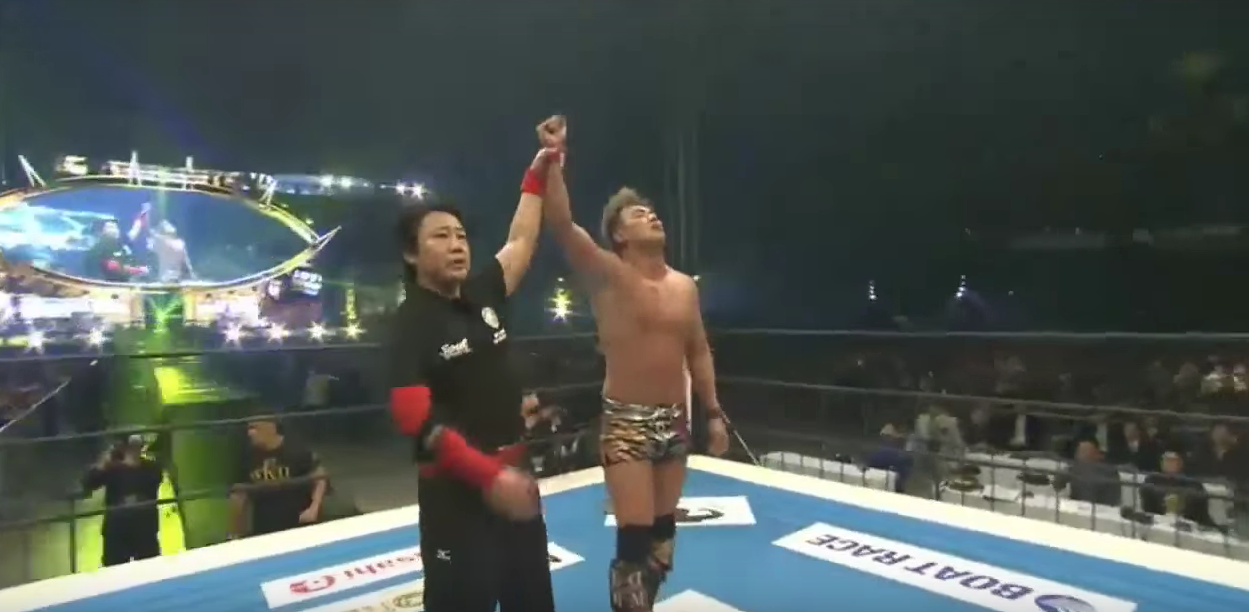You may as well just call it The Match. The main event of New Japan’s Wrestle Kingdom 11 last week, between IWGP heavyweight champion Kazuchika Okada and challenger Kenny Omega, was instantly hailed as a masterpiece in the wee hours of the American morning. Pro wrestling journalist Dave Meltzer, normally hesitant to gush too much over well-regarded matches, described it as one of the greatest matches he’d ever seen, maybe the greatest.
The story coming in was classic, pitting the two brightest stars in Japan’s wrestling scene against one another. It was a back and forth affair, which Okada won, and featured some incredible highlights. Both men took legitimate beatings and did some things for the sake of spectacle they probably shouldn’t have—Okada being dropped right on top of his head for a spot stands out—but it all cohered into one of the most thrilling matches of the decade.
Videos by VICE
Omega has long simmered as the next big thing in Japan, and Wrestle Kingdom 11 capped a career year which saw him become the first non-Japanese winner of the G1 Climax tournament. He works the perfect style for the country’s wrestling culture, a mix of raw athleticism, hard strikes, willingness to get hit for real, and a flair for the physically dramatic.
Read More: The Invincible, Vulnerable Lex Luger Belongs in the WWE Hall of Fame
He’s also not afraid of comedy wrestling or acknowledging the artifice of the whole thing, a trait he shares with his fellow Bullet Club members, the Young Bucks. This sours more old school types on him, notably Jim Cornette.
There’s a dichotomy at work in how people react to Omega’s career trajectory, one which reveals a larger split in how pro wrestling is thought of. When Kenny Omega is brought up as a non-serious wrestler, it’s a fair point. His first big taste of mainstream attention was when he wrestled a 9-year-old. To those who still dwell in a world in which we should pretend wrestling is real in the sense that other sports are real, this was a cardinal sin.
But it also ignores a fair amount of context. Japan isn’t the United States. It’s Japan, where pro wrestling embraces the absurdity underpinning the entire thing. It’s a place where Kota Ibushi can wrestle (and lose to) a blowup doll without damaging his career. It’s where one of the most globally revered stars, Keiji Mutoh, can take part in an angle involving spitting poison into a woman’s crotch in order to create an egg which gives birth to Akebono and nobody bats an eye.
But Omega isn’t Japanese. He’s Canadian. And because of this, the stragglers in accepting him are buying into a certain cultural conservatism. Namely, that a Japanese wrestler can do this weird shit and still come out as well-regarded, even worshipped, but a Canadian or American wrestler is forever tainted by the culture. Omega is good, certainly in the top ten in the world, and the scary part is that he’s getting better.
His opponent in the match, Kazuchika Okada, is being talked about less, but he deserves much more credit for the match than he’s getting. Omega was the spotlight wrestler: it was his year, from start to finish, but underpinning everything has been Okada, NJPW’s rock solid heart.
Okada has to be talked about as one of NJPW’s greatest champions at this point. The weird thing is, he’s comparatively wet behind the ears—he’s not quite 30 and has only really been in NJPW’s main event scene for five years. This is a grain of sand in pro wrestling terms, where great champions work two decades and careful pro wrestlers can carry on into their late 40s, albeit at diminished pace.
He serves as a great foil to Omega’s faster pace. Okada is deceptively big and strong, but works with a deliberate style which feels almost like Ric Flair in his prime, albeit with a much faster and more athletic set of moves.
Where Omega was content during the match to drop his breathtakingly athletic moves, Okada served to keep things at a relatively measured pace. Without Okada, the bout would’ve run the risk of becoming a spotfest: a collection of nearly unconnected, yet always impressive, moves. Okada would bring it back, slowing things down, linking moves together. It was masterful understatement, which served the extra purpose of keeping the spotlight on Omega, right where it was when the match began.

When you’ve just won the match of your life. Photo: YouTube.
Yet for all the gushing about the match, wrestling Twitter wasn’t so sure. The beginning was a little too slow, or the end a little too fast. The moves were too big, sometimes, the bumps too jarring. It was good, yes, but the best ever?
The incongruity of squaring how good the match was without yielding to the pressure of declaring it an all-timer caused exactly the sort of mind-numbing argument various fandoms, sports or otherwise, tend to descend into. Enjoy it, yes, but enjoy it just the right amount, never too little or too much. An argument on similar lines broke out around the Will Ospreay vs Ricochet match last year. It was a highly choreographed affair, as much gymnastics exhibition as pro wrestling.
The common thread in all the complaints and praise is Japan. Whatever else, Japan’s wrestling culture is once again defining the boundaries of discussion for what wrestling is and should be. That doesn’t mean we’re soon going to be watching blowup dolls wrestling every week, but it does mean that the high impact, choreographed is set to go global as more and more indies, WWE, and an ever more accessible NJPW beam it into our living rooms and local armories.
Even if Omega vs Okada was merely “very good” for you, having more matches like this would not be a bad thing at all.
Want to read more stories like this from VICE Sports? Subscribe to our daily newsletter.




